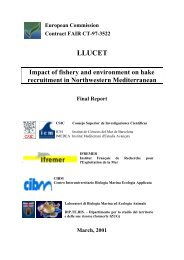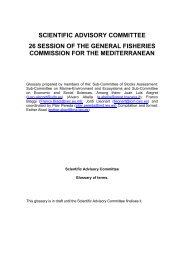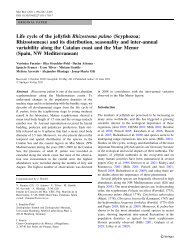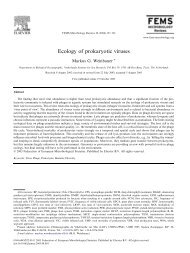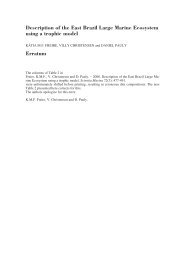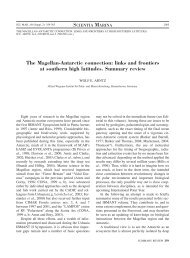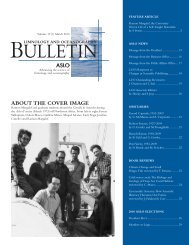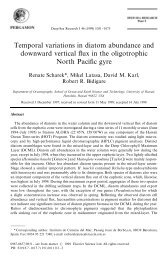REPORT OF THE WORKSHOP ON TRAWL SURVEY ... - FAO.org
REPORT OF THE WORKSHOP ON TRAWL SURVEY ... - FAO.org
REPORT OF THE WORKSHOP ON TRAWL SURVEY ... - FAO.org
You also want an ePaper? Increase the reach of your titles
YUMPU automatically turns print PDFs into web optimized ePapers that Google loves.
Maritime Districts of Ancona and San Benedetto del Tronto, central Adriatic Sea, Italy”. The<br />
sampling was performed with commercial vessels using hydraulic dredges. The results are<br />
synoptic maps and frequency distributions.<br />
Abstract: A large fleet of hydraulic dredgers has been targeting the clam Chamelea gallina in the Adriatic Sea for<br />
the past 30 years. The fishery has progressively reached a status of great economical importance for the fishing<br />
community. Following request of the Italian Ministry of Agriculture and Forestry, the clam resources in the entire<br />
Adriatic Sea have been assessed through hydraulic dredge surveys annually from 1984 to 2001. This presentation is<br />
aimed at summarising the methodologies adopted for such assessment in two Maritime Districts of the central<br />
Adriatic (Ancoan and S. Benedetto del Tronto) as well as the results obtained from 1984 to 2001.<br />
Conclusions from the Session 1<br />
• Within the discussion that developed, it was concluded that surveys performed in<br />
different GFCM GSAs have the same objectives and obtain similar results although<br />
they are not comparable since the methodology is not standard. It was stressed that<br />
there is a need to normalize and standardize trawl survey procedures and methods<br />
among all Mediterranean countries.<br />
• It was noted that GFCM can play a paramount role on this issue. The development of<br />
standardized guidelines for trawl surveys was considered necessary. For this reason,<br />
the establishment of a common protocol by the GFCM is recommended.<br />
• The establishment of a permanent working group to undertake this issue was<br />
discussed. The Permanent Working Group on Stock Assessment Methodology was<br />
mentioned, which could be used for these purposes.<br />
SESSI<strong>ON</strong> 2. METHODOLOGIES FOR <strong>TRAWL</strong> <strong>SURVEY</strong> DATA USED TO ASSESS<br />
FISHERY RESOURCES AND <strong>THE</strong> ECOSYSTEM, INCLUDING <strong>THE</strong> USE <strong>OF</strong> <strong>THE</strong><br />
BIOLOGICAL AND ECOLOGICAL INDICATORS<br />
9. The presentations for this session were divided in four parts:<br />
Survey methodology<br />
10. Two presentations were made under this topic. The abstracts of the presentations are<br />
given below:<br />
• A proposal for reducing haul time in the Mediterranean experimental bottom trawl<br />
surveys (by F. Bertolino, M.L. Bianchini, S. Gancitano, G.B. Giusto, G. Sinacori, S.<br />
Ragonese)<br />
Abstract: Experimental bottom trawl surveys (EBTSs) must cope with the exigency of good estimates precision<br />
(i.e., many short hauls) and the need of gathering representative samples. Most Mediterranean EBTSs have adopted<br />
half to one hour effective haul bottom times (EHBT), which are set by adding a depth varying lag to the time at<br />
which the winch stop occurs. However, evidences have piled up outside the Mediterranean about the ability of the<br />
gear to yield representative biological samples even in short haul times, as a consequence of the interaction of<br />
different factors. From Minilog data gathered during an EBTS carried on in the Strait of Sicily (program Grund<br />
2005), measured EHBT were compared by depth strata (shelf, upper and middle slope) with the corresponding<br />
nominal EHBT. Results indicate a not significant departure of measured and nominal EHBT, with different patterns<br />
among strata: measured EHBT was higher (+5 min), about the same (+1 min) and lower ( 2.5 min) in shelf, upper<br />
and middle slope respectively. Subsequently, hauls of the deepest stratum were split in 4 classes of increasing<br />
departure; notwithstanding departures of almost 15 min in some hauls, no substantial differences were appreciated<br />
in catch rates and LFD shapes, at least when considering the red shrimps (the most abundant target species). Even<br />
within the limits of the present study, it is suggested to consider the possibility of reducing, also for the<br />
Mediterranean EBTSs, the haul time to increase the precision of surveys.<br />
3




